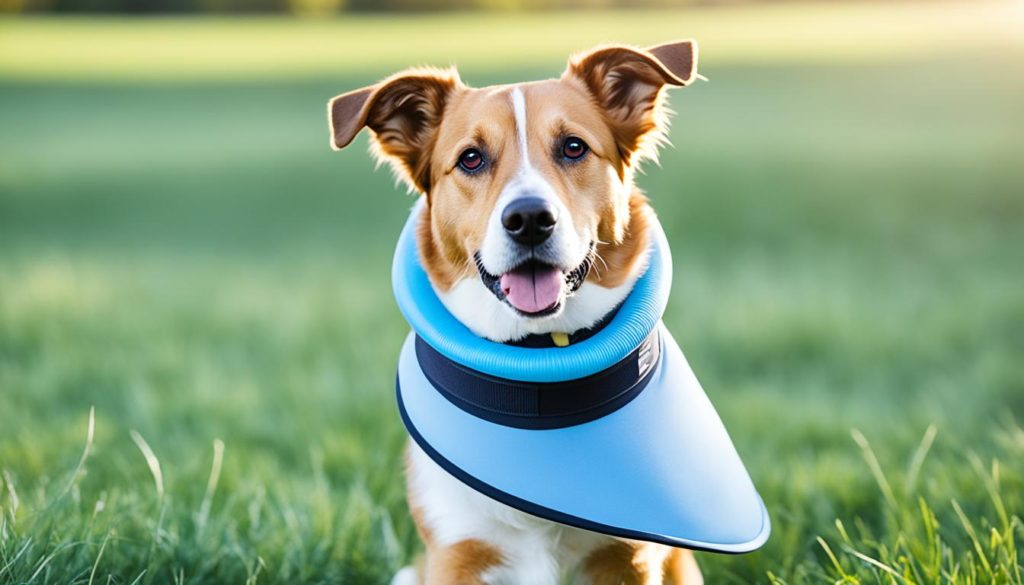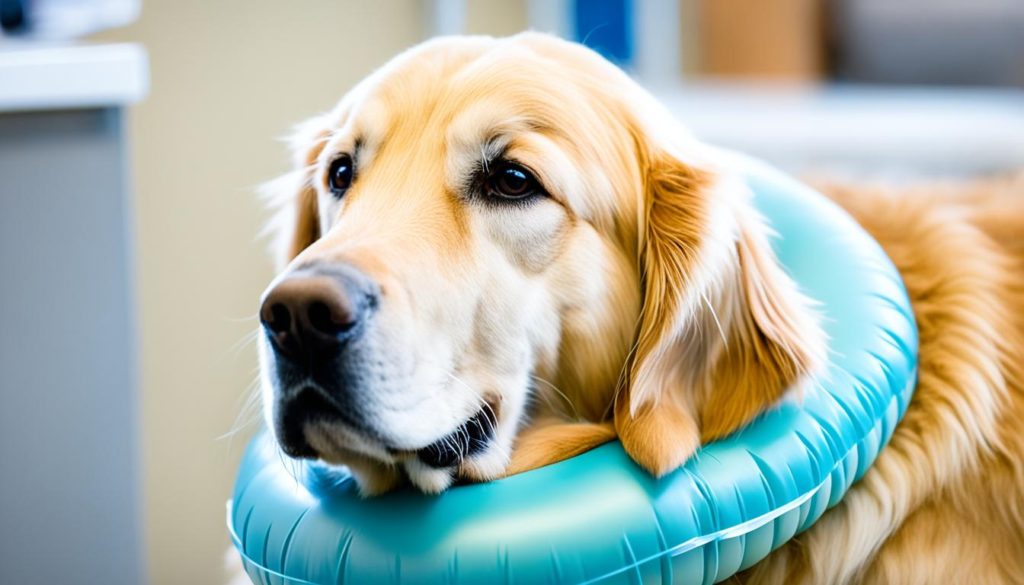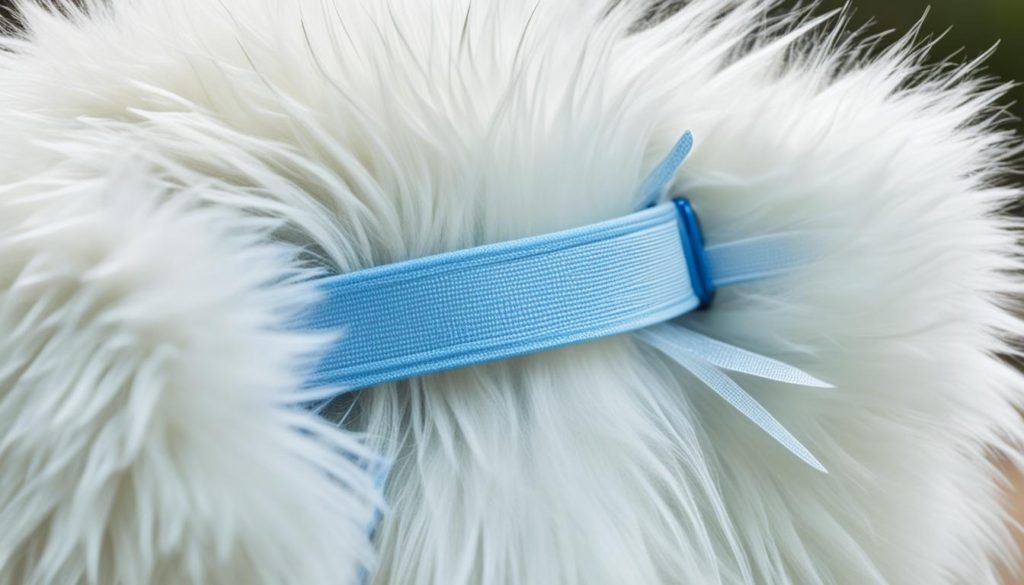After your dog undergoes surgery, it is important to provide them with proper post-operative care to ensure a smooth recovery. One essential aspect of this care is the use of a dog surgery collar, also known as an Elizabethan collar or E-collar. These collars are prescribed by veterinarians to prevent dogs from licking or biting at their surgical incision, which can lead to infection or reopening of the wound. While the concept of a cone collar may seem uncomfortable, dogs usually adapt to wearing them quite easily. In addition to wearing the collar, there are several important tips to follow to ensure your dog’s comfort and safety during the post-operative healing process.
Key Takeaways:
- Using a dog surgery collar, also known as an E-collar, is essential for preventing dogs from licking or biting their surgical incision.
- Proper sizing of the collar is important to ensure it effectively prevents access to the surgical site.
- Help your dog adjust to wearing the collar by creating a safe space and providing extra supervision.
- Follow your veterinarian’s post-operative instructions for feeding, pain management, and activity restrictions.
- Monitor your dog’s surgical incision and report any signs of infection or complications to your vet.
How to Use an E-Collar Effectively
When using a dog surgery collar, such as a surgical collar for dogs or a recovery collar for dogs, it is crucial to select the right size for your pet’s face. This ensures that they cannot reach the surgical site and interfere with the healing process. The length of the collar should be determined based on the size of your dog’s face and their ability to access the affected area.
Helping your dog adjust to wearing the E-collar is essential for their comfort and overall well-being. Although it may cause some inconvenience or require extra effort on your part, it is important to remember that it is only temporary and necessary for your dog’s recovery. To assist your dog during this adjustment period, consider the following:
- Moving valuable items: Place valuable items, such as decorations or fragile objects, on higher shelves or out of reach to prevent any collisions with the collar.
- Using harnesses: If your dog has difficulty navigating with the collar, you can try using a harness for walks or outings, providing them with comfortable support without hindering their movement.
- Creating a safe space: Establish a quiet and secure area in your home where your dog can relax and rest without feeling isolated. This space can help prevent injuries or accidents during the recovery period.
- Raising food bowls: Elevate your dog’s food and water bowls to a more accessible height, ensuring they can comfortably eat and drink without any interference from the collar.
- Keeping the collar clean and dry: Regularly inspect and clean the collar to prevent the buildup of dirt or moisture that could lead to hot spots or infections.
If your dog is struggling to adapt to the E-collar or is crafty enough to remove it, it is important to consult your veterinarian for alternative options or tricks to keep the collar in place. They can provide valuable guidance and recommend the best dog surgery collar for your pet’s specific needs.
Remember, using an E-collar is a temporary measure aimed at ensuring your dog’s post-operative recovery is successful. By taking the necessary steps to help your dog adjust to wearing the collar and providing a comfortable environment, you can ensure their healing process is smooth and uninterrupted.
Follow Your Vet’s Post-Op Instructions for Optimal Recovery
Your veterinarian will provide you with specific post-operative instructions based on the type of surgery your dog underwent. These instructions are essential for the proper care and recovery of your pet. It is important to follow these instructions closely to ensure optimal results.
Your vet may provide guidelines for feeding your dog after surgery, including offering light meals in smaller portions to prevent nausea and gradually transitioning back to their regular diet. Pain management is another crucial aspect of post-operative care, and your vet will prescribe any necessary medications to relieve discomfort.
**Administer these medications as instructed** and seek clarification from your vet if needed.
“I remember when my dog, Bella, had surgery on her leg, the vet provided detailed instructions for her recovery. She told me to keep her on a strict feeding schedule to prevent any digestive issues and gave me medication to manage her pain. It was important to adhere to these instructions to ensure Bella’s optimal recovery.” – Sam, dog owner**
Additionally, your vet may recommend limiting your dog’s activity and movement to prevent strain on the wound and potential complications. It is important to provide a comfortable and quiet environment for your dog during recovery, as well as prevent them from licking or chewing the wound by using a **protective collar for dog surgery**. Regular follow-up appointments with your vet are also necessary to monitor your dog’s progress and identify any signs of infection or other complications.

**Here’s a visual representation of a dog wearing a protective collar after surgery:**
**Figure 1: A dog wearing a protective collar for post-surgery recovery.**
Managing Your Dog’s Post-Surgical Incision
It is crucial to closely monitor your dog’s surgical incision and take appropriate measures to promote healing and prevent infection. One effective way to prevent your dog from licking or chewing the incision site is by using an inflatable dog collar for surgery or a dog cone alternative. These alternatives provide a comfortable and effective solution while still preventing access to the wound.
The incision should appear clean with properly aligned edges, and the surrounding skin should have a normal or slightly reddish-pink color. It is normal for bruising to occur, especially in pale-skinned dogs, but it should diminish within a few days. However, if you notice any continuous or excessive blood drainage, prolonged intermittent blood seepage, excessive swelling or redness, or unpleasant odor or discharge, it is crucial to contact your veterinarian immediately.
To ensure proper healing, stitches or sutures may need to be removed within a specific timeframe, usually around 7 to 14 days, depending on the type of surgery. Your veterinarian will provide guidance on when to bring your dog in for suture removal or if dissolvable stitches were used.
At-a-Glance Guide: Monitoring Your Dog’s Incision
| Signs of a Normal Healing Incision | Signs of Infection or Complications |
|---|---|
|
|

Remember, closely following your veterinarian’s instructions and regularly monitoring your dog’s incision will help ensure a successful recovery. By utilizing inflatable dog collars for surgery or other cone alternatives, you can provide your pet with a comfortable and effective solution while promoting proper healing.
Helping Your Dog Adjust and Stay Comfortable during Recovery
Recovery can be a challenging time for dogs, as they may experience frustration, itchiness, and reduced stimulation. It is important to provide your dog with mental and physical enrichment while maintaining activity restrictions.
Gentle games, such as chew toys and squeaky playthings, can help keep your dog amused without causing strain on the wound. However, it is important to limit the number of toys and treats to prevent overstimulation and weight gain.
Spending quiet time with your dog, calmly stroking their fur and providing reassurance, can also help them stay calm and feel loved during the recovery period.
“Recovery can be challenging, but with a little extra love and attention, you can help your furry friend adjust and stay comfortable.”
Remember, each dog’s recovery process is unique, so it’s important to adapt these strategies to your dog’s individual needs and temperament.
Activities to Keep Your Dog Comfortable and Engaged
- Provide puzzle toys that offer mental stimulation without requiring excessive physical activity.
- Engage in low-impact exercise, such as short walks on a leash or gentle stretching exercises that are approved by your veterinarian.
- Introduce new and interesting scents to stimulate your dog’s sense of smell.
- Offer interactive playtime with you or other suitable pets in a controlled and supervised environment.
Creating a Calm and Soothing Environment
- Designate a comfortable and quiet space for your dog to rest and recover, away from excessive noise or activity.
- Provide cozy bedding and blankets to promote relaxation and comfort.
- Use calming aids such as pheromone diffusers or calming music to help reduce anxiety.
Remember, the goal is to keep your dog calm and comfortable while promoting a healing environment. By providing mental stimulation, engaging in gentle activities, and creating a soothing atmosphere, you can help your dog adjust and recover smoothly.
| Activity | Description |
|---|---|
| Chew Toys | Provide soft and durable chew toys to keep your dog entertained without exertion. |
| Puzzle Toys | Engage your dog’s mind with interactive puzzle toys that require problem-solving skills. |
| Gentle Walks | Take short, controlled walks on a leash to provide light exercise without straining the surgical area. |
| Sniffing Games | Hide treats or toys around the house for your dog to find using their sense of smell. |
Typical Recovery Times and Resuming Normal Activities
After your dog undergoes surgery, the recovery time will vary depending on the type of procedure. Soft tissue surgeries, such as spaying or neutering, usually heal about 80% within 2-3 weeks and fully recover in about 6 weeks. On the other hand, surgeries involving bones and ligaments may require a longer recovery period.
During the recovery phase, it is crucial to restrict your dog’s activity as recommended by your veterinarian. This helps prevent strain on the wound and ensures proper healing. It’s important to follow these activity restrictions diligently to avoid setbacks in your dog’s recovery.
Swimming and baths should be avoided during the recovery period to prevent infection. Moisture can interfere with the healing process and increase the risk of complications. Your veterinarian will provide you with detailed instructions on activity restrictions and other post-operative guidelines to ensure your dog’s optimal recovery.
Table: Typical Recovery Times for Different Types of Surgeries
| Surgery Type | Recovery Time |
|---|---|
| Soft tissue surgeries (spaying or neutering) | 2-3 weeks (80% recovery), fully recover in about 6 weeks |
| Bone and ligament surgeries | Varies, longer recovery period |
Resuming normal activities should be done gradually and under the guidance of your veterinarian. It’s essential to observe your dog for any signs of discomfort or complications as they gradually return to their regular routine. Monitoring their response to increased activity will help ensure their full recovery.
Conclusion
Proper post-operative care plays a crucial role in the successful recovery of dogs after surgery. Using a recovery collar for dogs, such as a dog cone after surgery, is an essential part of this care. By following your veterinarian’s instructions, monitoring the surgical site, and providing comfort and enrichment for your dog, you can ensure a smooth healing process.
Remember that your veterinarian is your best resource for guidance and support during your pet’s recovery journey. Consult them with any concerns or questions you may have. They will provide tailored instructions based on your dog’s specific needs, ensuring the optimal recovery for your beloved companion.
By prioritizing your dog’s post-operative care, from using a recovery collar for dogs to following your vet’s recommendations, you can help your furry friend recover quickly and safely. The recovery process may require patience and diligence, but the end result will be a happy, healthy dog ready to resume their normal activities.
FAQ
What is a dog surgery collar?
A dog surgery collar, also known as an Elizabethan collar or E-collar, is a collar prescribed by veterinarians to prevent dogs from licking or biting at their surgical incision after surgery.
Why is it important for dogs to wear a surgery collar?
Dogs need to wear a surgery collar to prevent them from licking or biting at their surgical incision, which can lead to infection or reopening of the wound.
How do I select the right size dog surgery collar?
The length of the cone collar should be determined based on the size of your dog’s face and their ability to access the affected area. Consult your veterinarian for guidance on selecting the appropriate size.
How can I help my dog adjust to wearing the E-collar?
To help your dog adjust, you can move valuable items to higher shelves to prevent collisions with the collar, use harnesses for navigation, and create a safe space to prevent injury and isolation from other pets.
What should I do to prevent my dog from removing the collar?
If your dog is having difficulty adapting or is crafty enough to remove the collar, consult your veterinarian for alternative options or tricks to keep the collar in place.
What post-operative instructions should I follow?
It is important to closely follow the post-operative instructions provided by your veterinarian specific to your dog’s surgery. These instructions may include guidelines for feeding, pain management, and activity restrictions.
How do I monitor my dog’s surgical incision?
Monitor the surgical incision for any signs of continuous or excessive blood drainage, prolonged intermittent blood seepage, excessive swelling or redness, unpleasant odor, or discharge. Report any concerning signs to your veterinarian.
How long does it take for my dog to recover after surgery?
The recovery time varies depending on the type of surgery. Soft tissue surgeries usually heal about 80% within 2-3 weeks and fully recover in about 6 weeks. Surgeries involving bones and ligaments may require a longer recovery period.
What can I do to provide mental and physical enrichment during my dog’s recovery?
Gentle games, such as chew toys and squeaky playthings, can help keep your dog amused without causing strain on the wound. Spending quiet time with your dog, calmly stroking their fur and providing reassurance, can also help them stay calm and feel loved during the recovery period.
Can I bathe my dog during the recovery period?
It is generally recommended to avoid bathing or swimming during the recovery period to prevent infection. Consult your veterinarian for specific guidelines regarding bathing and grooming.
